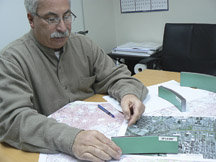Even though energy company officials have changed the route of a proposed gas pipeline under Bayonne and Jersey City, some critics have still not been swayed.
The residents have said they’d like to see the proposed Spectra Energy pipeline run under the Hudson River and not near residential neighborhoods.
The 15.5-mile pipeline is intended to carry 800 million cubic feet of natural gas per day through Hudson County to New York City customers of Con Edison.
“It doesn’t make sense at a time when we are moving toward clean energy solutions.” – Andrea Morin
________
Opponents of the project have started a website, www.NoGasPipeline.org, to inform the public.
Still opposed and not stopping
Rather than its original controversial route, Spectra filed an application in December with FERC for a pipeline design that avoids residential properties, buries the pipeline 80 to 100 feet underground rather than parallel to the street, and calls for Spectra employees to patrol the pipeline seven days a week.
Opposition both verbal and legislative on Spectra’s pipeline plans has been led by the Jersey City group NO Gas Pipeline, which since last year has worked with City Hall to stop the pipeline.
NO Gas Pipeline co-founder Dale Hardman, a downtown resident, said last week that he isn’t impressed with the route change.
“Spectra continues to ‘spin’ their changes to the pipeline route as claiming it shows their concern for Jersey City in their formal filing,” Hardman said. “Spectra wants to route their pipeline through Jersey City for one reason: profit.”
Mayor Healy’s spokesperson, Jennifer Morrill, said Healy agrees with Hardman that the changes in the pipeline route are not acceptable.
“The mayor remains committed to opposing the pipeline and the change we want to see is the pipeline being re-routed out of Jersey City,” said a statement.
Taking legal action
The next tactic by both the group and the city is to file for intervenor status with the Federal Energy Regulatory Commission (FERC). They can file this once they receive a “notice of application” that officially announces Spectra’s application has been received and processed.
Being granted intervenor status means having legal standing if a lawsuit is filed to stop the pipeline.
Hardman and Mayor Healy also would like to see Gov. Christopher Christie intervene with FERC. He noted that Christie intervened recently regarding a Liquid Natural Gas pipeline proposed to run through Perth Amboy.
Also, the city, in conjunction with the Jersey City Municipal Utilities Authority, recently retained the legal services of Carolyn Elefant, a Washington D.C. attorney specializing in FERC matters.
Timeline
Spectra’s project manager, Ed Gonzales, said last week at the company’s downtown Jersey City office that an underwater route was considered but eliminated. The Port Authority of New York and New Jersey was concerned that the pipeline would be built too close to the PATH tunnels, as well as the Holland Tunnel. Other obstacles included weather restrictions while working in the water and construction interfering with river traffic.
FERC, according to Gonzales, is expected to issue a decision by June. If approved by the necessary agencies, the $850 million pipeline would start construction in spring 2012 with scheduled completion by November 2013, when the pipeline would be put into service.
Gonzales showed off models of the 30-inch diameter pipe, pointing out that through most of the route the pipeline will be .75 inches thick. This factor, coupled with the ductile (flexible) qualities of the pipe, makes it safe from corrosion and seismic shock.
“It will be a state-of-the-art pipeline,” Gonzales said.
Is there an upside?
Gonzales said the pipeline will no longer run near First Street in Bayonne.
“Before, we were looking at physically working on First Street,” Gonzales said. “But because of the concerns raised, we looked at modifying our alignment.”
Gonzales touted the economic benefits of the pipeline, citing a study commissioned from the Rutgers University Bloustein School of Planning and Public Policy claiming it would generate $78 million in tax revenue for the city and create 1,437 jobs over 20 years.
He also offered letters of support from local unions whose members may be employed on the project, such as the Hudson County Building Construction Trades Council. In their letter, they state: “Some may be inconvenienced or annoyed by this project but its benefits to the region far outweigh their parochial interests.”
Ricardo Kaulessar can be reached at rkaulessar@hudsonreporter.com.
Artful opposition
Besides orthodox means of opposition of the proposed Spectra gas pipeline, a slightly unorthodox form presented itself Tuesday night with the opening reception of the art exhibition, “Dark Matter: Bright Future?” at the bar/restaurant LITM in downtown Jersey City.
Over 40 art pieces from various local artists expressed their reactions to the possibility of a pipeline running through their town.
The exhibition’s curator, downtown resident Andrea Morin, spoke about the exhibition, which she created after finding out about the pipeline a few months ago.
“[The pipeline] doesn’t make sense to me,” Morin said. “It doesn’t make sense at a time when we are moving toward clean energy solutions, they want to install a gas pipeline in a densely populated area.”
